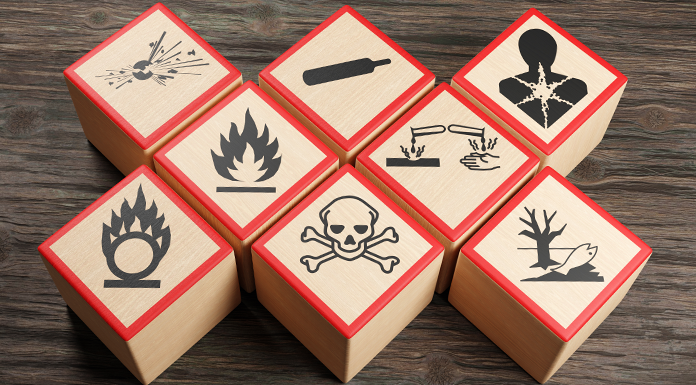Hazard Communication is once again the second most cited OSHA standard in 2023. Violations of this standard revolve mainly around the handling, management, and storage of harmful chemicals in the workplace.
OSHA has had a standard in place for hazard communication since 1983, and it has been updated several times throughout the years. Overall, the purpose of the standard is to ensure that the hazards of all chemicals produced or imported are classified and that information concerning the classified hazards is transmitted to employers and employees. In 2022, OSHA issued a total of 2,682 violations, and that number rose to 3,213 in 2023. The five most cited violations include the following:
- 1910.1200(e)(1): Employers shall develop, implement, and maintain at each workplace a written hazard communication program that at least describes how the criteria specified in paragraphs (f), (g), and (h) of this section for labels and other forms of warning, Safety Data Sheets, and employee information and training will be met. (978 violations).
- 1910.1200(h)(1): Employers shall provide employees with effective information and training on hazardous chemicals in their work area at the time of their initial assignment and whenever a new chemical hazard the employees have not previously been trained about is introduced into their work area. Information and training may be designed to cover categories of hazards (e.g., flammability, carcinogenicity) or specific chemicals. Chemical-specific information must always be available through labels and Safety Data Sheets. (713 violations)
- 1910.1200(g)(8): The employer shall maintain in the workplace copies of the required Safety Data Sheets for each hazardous chemical and shall ensure they are readily accessible during each work shift to employees when they are in their work area(s). (285 violations)
- 1910.1200(f)(7): Workplace labeling. Except as provided in paragraphs (f)(7) and (f)(8) of this section, the employer shall ensure each container of hazardous chemicals in the workplace is labeled, tagged or marked. (252 violations)
- 1910.1200(g)(1): Chemical manufacturers and importers shall obtain or develop a Safety Data Sheet for each hazardous chemical they produce or import. Employers shall have a Safety Data Sheet in the workplace for each hazardous chemical that they use. (199 violations)
Common Hazard Communication/Chemical Hazards
A hazard communication program aims to increase the level of protection against chemical hazards and improve how employees handle, store, and transport dangerous chemicals at work. The most effective way to raise awareness around the hazards associated with the chemicals is through annual “Right To Know” training. During the training, make sure to discuss the following with your employees:
- Health hazards – Can result from overexposure to a hazardous substance, ranging from minor inconveniences like headaches and skin rashes to much more serious afflictions such as skin burns, organ damage, allergic-type reactions, and even death.
- Environmental/community risks – When hazardous substances are spilled or released into water supplies or the air.
- Fire or explosion – If a tank of compressed gas is punctured.
Hazard Communication Safety Tips
Employees have a right to know what chemicals are in the workplace, the hazards that are associated with the chemicals, and the proper methods of controlling those hazards. Without proper measures in place, the chemicals utilized in the workplace can easily become hazardous to not only the user but also to others working nearby.
Ten essential hazard communication safety tips to follow include:
- Develop and implement a hazard communication program describing how you will ensure containers are properly labeled.
- Keep a list of hazardous chemicals known to be present at the worksite; maintain a current safety data sheet for each listed chemical.
- Provide employees training on the requirements of the OSHA standard, where hazardous chemicals may be present, the location of the written program and safety data sheets, methods used to detect chemical releases, hazard classifications of chemicals in their work areas, and also measures used for protection from hazards.
- Never allow employees to bring in and utilize any chemicals without management’s approval.
- If possible, do not allow secondary containers to be utilized within your facility. If there’s a situation where a chemical must be transferred to a secondary container, ensure the chemical is used immediately within a work shift by the same person who transferred the chemical.
- Ensure employees are prepared for emergency response. As much as we try to prevent accidents from happening, they sometimes inevitably occur, no matter how much preparation we perform now. When they do occur, as in a chemical spill or release, employees should be trained in the proper cleanup/spill procedures.
- Wear appropriate protective clothing and equipment (PPE); ensure you use the proper gloves for the task at hand.
- Keep hazardous materials in well-maintained storage areas (good ventilation and drainage). Regularly inspect storage containers to prevent corrosion, leakage, and containment failure.
- Practice good housekeeping procedures to prevent incompatibility and maintain the integrity of hazardous material storage containers (routinely and thoroughly check the state of containers and surrounding area for any holes, leaks, signs of rust or rot, missing labels, and always keep things as neat and clean as possible).
- Complete periodic evaluations of the chemical(s) utilized and decide if they are still needed. If not, remove the chemical(s). If so, find out if there is a safer alternative, then properly dispose of the old chemical(s). Purchase and train on the new alternative.
ICW Group’s Safety OnDemand portal, available for free to workers’ compensation policyholders, contains a full suite of safety resources, training, webinars, and a comprehensive learning management system to assist you with your hazard communication program. In addition, ICW Group offers a Hazard Communication Program Wizard and Hazard Communication Employer’s Guide to assist you with your Federal OSHA compliance efforts.
If you have any questions or need assistance with developing your program, please contact ICW Group’s Risk Management Services, and we will be more than happy to assist you.

















